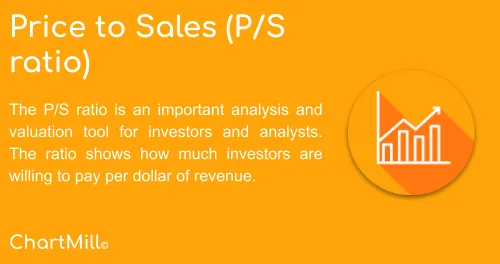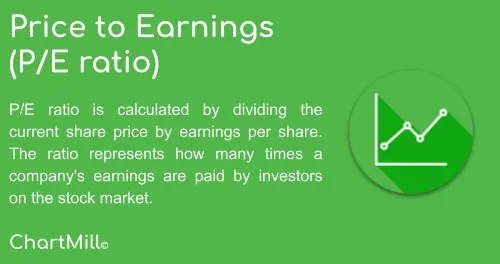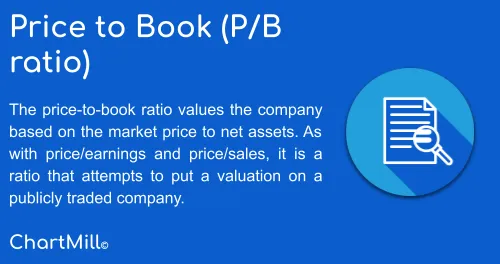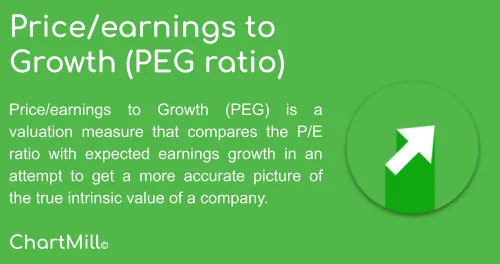
Price-to-Sales Ratio (P/S)
By Kristoff De Turck - reviewed by Aldwin Keppens
Last update: Apr 19, 2024
The P/S ratio is an important analysis and valuation tool for investors and analysts. The ratio shows how much investors are willing to pay per dollar of revenue.
Formula and explanation
The price-to-sales ratio can be calculated in two different ways. Either by dividing the company's market capitalization by total sales over a given period (usually 12 months).
P/S = Market Capitalization / Trailing 12-Month Revenue
P/S = (Number of Outstanding Shares * Current Share Price) / Trailing 12-Month Revenue
The typical 12-month period used for the P/S ratio is usually the past four quarters (also called trailing 12 months or TTM), or the most recent or current fiscal year (FY).
Another way is by dividing the stock price by sales per share. The P/S ratio is also known as sales multiple or revenue multiple.
P/S = Current Share Price / Trailing 12-Month Revenue per Share
P/S = Current Share Price / (Trailing 12-Month Revenue / Number of Shares Outstanding)
Like all ratios, the P/S ratio is most relevant for comparing companies in the same sector. A low ratio may indicate that the stock is undervalued, while a ratio that is significantly above average may indicate overvaluation.
When is the P/S ratio useful?
Investors use the price-to-sales ratio, which is similar to the better-known price-to-earnings ratio, as an indicator to get an idea of a stock's value. This ratio is calculated by dividing the stock price, which is determined by the market, by the company's annual sales.
While the P/E ratio compares a company's stock price to annual earnings, the P/S ratio measures the value of a stock relative to sales. Not all companies make profits every year, but that does not necessarily mean they are bad companies. This can be the case, for example, with start-ups or companies that are heavily influenced by economic fluctuations.
Therefore, a company that does not make a profit is not necessarily a bad investment. The P/S ratio provides a convenient way to evaluate and compare companies based on their sales, even if they have not made a profit or have not made a profit in the past 12 months. This makes it a popular ratio for valuing start-ups and high-growth companies.
Are there any drawbacks?
Since the P/S ratio does not take profits into account, it is not a reliable indicator of how profitable a company is or could become in the future. This means that the ratio, while useful for evaluating new and growing companies, is somewhat limiting.
Moreover, like the P/E ratio, this ratio does not take debt into account. A company may have a lower ratio than a competitor in the same industry, but may also have a higher level of debt, while its competitor may be debt-free.
As with most other metrics, the P/S ratio alone cannot be the sole decision factor for investors when buying or selling stocks. It is critical to look at a number of fundamental factors, both quantitative and qualitative, when evaluating a company to get a more complete picture of its financial and operational health.
What is considered a good P/S ratio?
A basic guideline is that a ratio lower than 2 is generally considered healthy and ratios lower than 1 are considered very good. However, it is important to note that the average value can vary greatly by industry. Therefore, it is recommended to first find out the average value for the P/E ratio of the industry the stock is in and then compare only companies within the same industry. Otherwise, you are comparing apples to oranges and possibly drawing wrong conclusions.
The reason why the average value for this ratio can vary greatly by sector is logical. One sector may be characterized by high turnover rates but small profit margins, while others benefit from high profit margins but have lower turnover rates.
You can check the Revenue multiples by sector through this link
Which is better; a high or low number?
There is no clear-cut answer to that question. Investors looking for bargains are likely to prefer companies with a low P/S ratio relative to their competitors in the same sector because they are looking for undervalued stocks.
However, this does not automatically mean that companies with a high P/S ratio should necessarily be avoided. A high P/S ratio is a clear sign that investors are willing to pay a high price. This may indicate overvaluation, but equally it may indicate that the company is attractive for the foreseeable future for other reasons. For example, the company may have specific knowledge or technologies that give it a unique position in the market and little competition, making it easy to raise its prices without losing many customers (‘pricing power’)
Conclusion
The P/S ratio is a useful tool for investors who wish to compare the performance of two or more similar companies. Because it does not look at earnings but rather at sales, this ratio is less susceptible to accounting manipulations. The fact that turnover is used in the formula means that this ratio is often used to compare new companies in a particular sector or industry that have not yet made a profit, as well as for more established companies that have not made a profit in the past 12 months due to economic cycles.
Of course, in addition to this ratio, you should also take into account other quantitative (cash flow, debt,...) and qualitative elements (moat? competitive advantages?...) to determine whether or not a company is worthy of buying.
Some other Valuation Ratios
Fundamental Valuation Filters
In this article we will discuss the fundamental filters related to the valuation of a stock. Read more...







